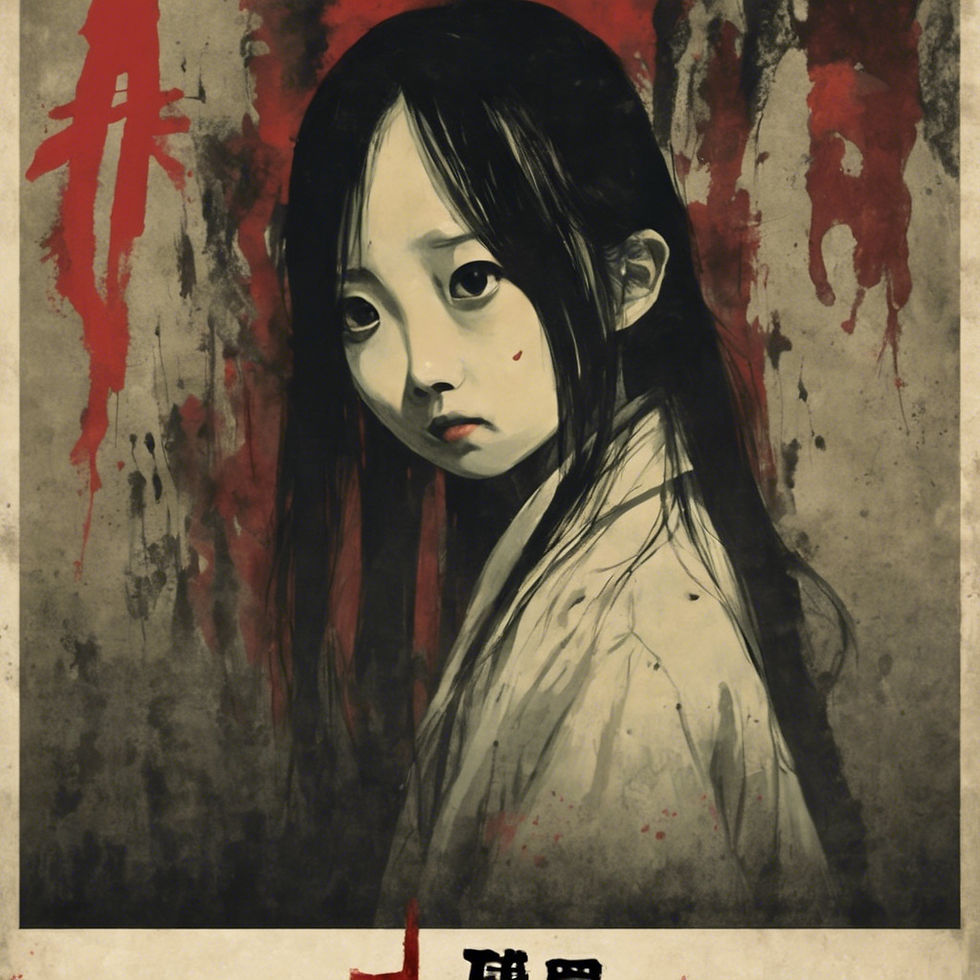‘ONRYOU’ IN ‘J – HORROR’ : A PORTAL TO THE POST WORLD-WAR SOCIOCULTURAL CONDITION OF WOMEN IN JAPAN. Part 3: SOCIO-CULTURAL IMPLICATIONS OF “ONRYOU” MOTIF IN FILMS
- Sharmistha Chakrabartty

- Apr 22, 2024
- 3 min read
This is the 3rd post in the series, which will talk about the Sociocultural implications of 'Onryou' motif in films. This is a six-part upload, do check out the other parts.

One of the most important and popular component of current J horror Cinema is the motif of ‘Onryou’ i.e. avenging spirit. These are the spirits of women, who have been wronged while they were alive (Wronged women), thus they have come back from the grave to exact revenge. Nakata’s Dark Water, Ringu and Shimizu’s Ju on: the grudge, all of them have this as the primary theme. As stated earlier,
the conflict in Japanese society revolves around ‘traditional Japanese’ and ‘Post-modern Japan’.
Gender inequality is one of the core features of this motif. Domestic violence is a prevalent part of Japanese society. It has never been considered a serious
social problem and this evident from the fact that in Japanese language, no word for ‘Domestic violence’ exists. In fact, Japan denied existence of such crime by considering the whole idea as ‘westernized’ or only happening in ‘low-income groups’. The crime towards women is often the negative consequence of how Japanese men were taught to behave. For Japanese men, Violence and aggression is given preference over verbalizing their emotions. In Introduction to Japanese Horror, Colette Balmain writes, "Painfully pent-up emotions then became directed towards intimate others in the private arena of the
home, men’s only ‘fort’ for safety reconfirming their masculine identity and pride (otoko no koken). Unfortunately, some men express ‘unmanly’ emotions in ‘manly’ fashion, using various (including verbal) forms of violence."
Another important component of contemporary Japanese Horror Cinema is “Breaking up of the nuclear family. This component is not exclusive to Japanese cinema. It is often found in Hollywood films like ‘The Amityville horror’, ‘The shinning’ ‘Hide and seek’ etc. In these stories, the threat is from inside rather than outside. Western Gothic stories show the ‘sin of father’ as the horrific ‘other’ which disrupts and threatens the nuclear family. Whereas, Japanese gothic story in centered on the ‘sins of mother’. Westernization of Japanese society and the effects of it that followed, resulted
in disruption of the ‘ie system’ and broke the family structure. Anxiety over this often takes shape of ‘haunted house stories’ in films. This structure of story is relatively new and can be directly associated with changing family structure, changing gender roles and economic recession of 1990s. Dark Water,
Ringu and Ju-on: Grudge all of them show nuclear families. Especially in Dark water and Grudge, the domestic arena (Uchi) which, is considered to be sacred turns into a place of fear and death.
Even in Japanese society and films, we find something similar to ‘Oedipus Complex’ or ‘Mother-fixation’. In fact, in contemporary Japanese society, the mother-child closeness (especially if it is a son) is promoted due to various factors like absence of father, mother being educated enough to support the household and teach the children. The mother figure is often ‘over – valorised’. In this context, Colette Balmain writes, " However, in popular culture, in opposition to this over-valorisation of the maternal, is the demonic or nightmare mother. As Goldberg writes: ‘the flipside of the idealized representation of Japanese motherhood, found in the haha-mono, is the bukimi’na haha: the nightmare mother who has a special link to madness or the supernatural’.” Since 1970, the traditional representation of the female characters changed. From kind, dependable mother and ever-suffering women, they have turned into ‘Demonic Mother’ (depraved and distorted version of the ‘dependable mother’).
This growth in representation of ‘Demonic mother’ is a result of feminist movement on 1970s and shifting Japanese society during and after the ‘Economic boom’. However this presentation is not completely reactionary. The three films which we will discuss next, would showcase this mother and child bond and the female characters in those films acts as ‘cultural barometer’ through which we can study the ‘gender behavior’ of Japan.
In the next post we will talk about, the film Dark Water by Hideo Nakata.
To be continued...
Let's give credit where it is due. The books I referred to :
Cherry, Brigid. ‘Horror’, Routledge Taylor and Francis Group, New York, (2009)
‘Horror to the extreme’, Hong Kong University Press, Hong Kong, (2009).
McRoy, Jay, ‘Nightmare Japan’, Rodopi, New York, (2008).
Balmain, Colette, ‘Introduction to Japanese Horror films’. Edinburgh University Press, Great Britain, (2008)


Comments